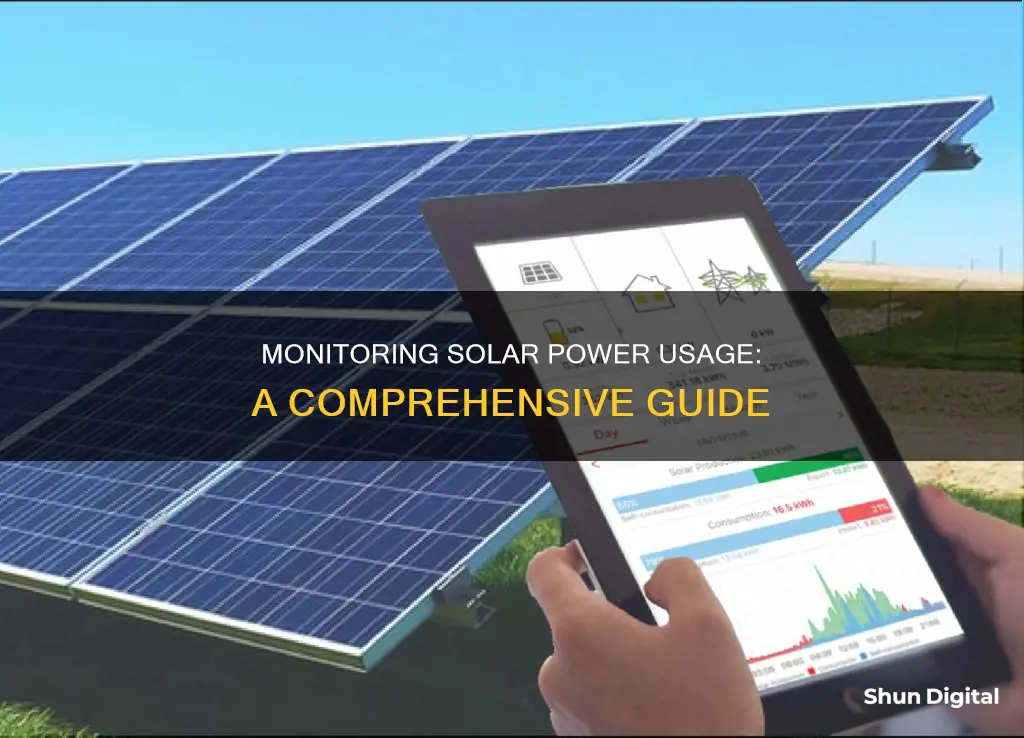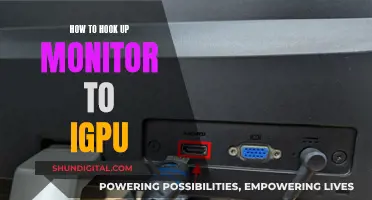
Solar power monitoring systems are an essential tool for homeowners and businesses looking to maximise their solar system's performance and save money. These systems provide data and insights on solar power production and usage, helping users make informed decisions about their energy habits and costs. The basic function of a solar power monitoring system is to track solar production and consumption, with more advanced systems offering features such as circuit and panel-level monitoring, performance and fault alerts, and cost tracking. This data is typically accessible via internet portals or smartphone applications, providing real-time and historical information on solar panel output and allowing users to identify any issues or abnormalities in their solar system's performance.
| Characteristics | Values |
|---|---|
| Purpose | Save money by maximising solar power production and self-consumption, and understanding fluctuations in energy bills |
| Data | Historical and real-time data on electricity produced, used, exported to the grid, and imported from the grid; temperature of panels; impact of shade; performance issues |
| Alerts | Performance and fault alerts via email or SMS |
| Cost | $300-$500 for a smart meter; $800+ for advanced monitoring systems; monthly subscription fee for most professional panel monitoring systems |
| Benefits | Early detection of abnormalities; increased solar power self-consumption; understanding fluctuations in electricity costs |
| Types | System Level Monitoring (SLM); Panel Level Monitoring (PLM) |
| Features | Circuit level monitoring; performance and fault alerts; cost tracking |
| Access | Internet portal or smartphone app |
What You'll Learn

Track solar production and consumption
Tracking solar production and consumption is essential to ensure your solar system is working properly and to maximise your solar power production and self-consumption. Solar monitoring systems provide real-time and historical data on solar energy production and consumption, allowing you to identify any issues and optimise your energy usage habits to save money on electricity costs. Here are some tips to help you track solar production and consumption:
Solar Monitoring Systems
Solar monitoring systems are a great way to track solar production and consumption. These systems are designed to help homeowners and businesses maximise their system's performance and save money. They can provide historical and real-time data on solar energy production, consumption, grid exports and imports, and even the temperature of your panels. You can access this information via an internet portal or smartphone application, allowing you to monitor your solar panels' performance remotely.
Inverters and Meters
Most solar inverters have a built-in production monitoring function, and some also include basic electricity consumption monitoring. However, if your inverter doesn't include consumption data or you want more detailed information, you can invest in a "solar smart meter" or an advanced monitoring system that integrates with your inverter. These meters can provide more in-depth consumption data and advanced analytics, helping you make informed decisions about your energy usage.
Apps
There are various smartphone applications available for tracking solar production and consumption. For example, the mySolarEdge app allows you to view your home energy production and consumption levels by simply tapping the Dashboard icon. The Freedom Forever App provides hourly measurements of power production, helping you determine when your system is producing the most power. The Enphase Enlighten app offers real-time and historical system data, allowing you to see data in multiple ways and link daily production records to local weather conditions.
Track Hourly, Daily, and Monthly Data
Solar monitoring systems can provide detailed data on solar energy production and consumption by the hour, day, or month. This allows you to monitor the historical performance of your solar panels and identify any variations in generation over time. By tracking this data, you can identify the best times of day to use energy-intensive appliances to maximise your solar power self-consumption.
Identify Abnormalities and Faults
Solar monitoring systems can help detect abnormalities and faults in your solar power production. They can alert you when your system isn't producing power as expected, allowing you to take prompt action to rectify the issue. Additionally, some advanced monitoring systems can provide performance and fault alerts via email or SMS, ensuring you're promptly notified of any issues.
By utilising these tools and tips, you can effectively track solar production and consumption, optimise your energy usage, and maximise the benefits of your solar panels.
Monitoring App Usage: iPad Settings for Parents and Guardians
You may want to see also

Understand your electricity costs
Solar monitoring systems can help you understand your electricity costs and save money. They can provide you with data on your solar energy production and consumption, as well as your usage habits, which can help you make changes to reduce your electricity costs.
Solar power monitoring systems will generally show you how much electricity your solar panels are producing and will also record the total amount of solar power generated over time. This information can help you monitor the historical performance of your solar panels by comparing previous readings and tracking any variations in generation from one period to another.
You can access this information through an internet portal or smartphone application, which will usually update every few seconds. Some systems also offer downloadable mobile applications, so you can track your solar power production from anywhere.
Additionally, some monitoring systems provide real-time data on how much electricity your panels are producing, the temperature of your panels, and how much impact shade has on their output. This can help you make adjustments to improve your system's performance and save money.
It's important to note that your solar inverter may only provide basic data and monitoring capabilities. For more detailed data and information, you may need to invest in a third-party solar power monitoring system or a "solar smart meter". These advanced monitoring systems can provide in-depth analysis and help you track the performance of your inverter and solar panels more closely.
With a dedicated third-party solar power monitoring system, you can benefit from early detection of abnormalities in solar power production, increased solar power self-consumption, and a better understanding of fluctuations in your electricity costs. These systems use advanced algorithms to interpret and deliver your energy consumption and solar PV system performance data in an easy-to-understand way.
Furthermore, some advanced solar power monitoring systems offer cost-tracking features, allowing you to input your daily supply charge, time-of-use tariff information, and other relevant data. With this information, the system can provide a detailed breakdown of your expected electricity costs for a specific period.
By understanding your electricity costs and having access to detailed data, you can make informed decisions to optimise your solar power system and reduce your overall electricity expenses.
Monitoring Memory Usage: CloudWatch Strategies and Insights
You may want to see also

Monitor solar panel output
Monitoring your solar panel output is essential to understanding your solar system's performance and ensuring you're saving money on your electric bills. Here are some detailed instructions on how to monitor your solar panel output:
Understand the Basics of Solar Monitoring:
Start by familiarising yourself with the basics of solar power monitoring systems. These systems are designed to help you track your solar energy production and consumption, allowing you to make informed decisions about your energy usage.
Choose a Solar Monitoring System:
Select a solar monitoring system that suits your needs. You can choose between built-in inverter monitoring systems, which are now included with most solar power inverters, or opt for a third-party monitoring system that offers more in-depth analysis and features. Some popular third-party systems include Solar Analytics, Fronius, and Sense.
Set Up Your Monitoring Platform:
Connect your solar monitoring system to the internet. This can be done through a physical Ethernet cable, Wi-Fi, or a cellular modem with a data plan. Most systems will send data to an external server, allowing you to access the information through an online monitoring platform or a mobile application.
Access Real-Time and Historical Data:
Log into your monitoring platform or mobile app to view real-time data on your solar panel output. You can also compare historical data to track any variations in performance over time. This information will help you identify any issues or abnormalities in your solar panel's output.
Set Up Alerts:
Configure email or text alerts to notify you when your solar panel's output is not optimal. This way, you can address any technical difficulties or performance issues promptly without waiting for your electric bill to arrive.
Consider Module-Level Monitoring:
If your system supports it, opt for module-level monitoring. This feature allows you to monitor the output of individual solar panels, making it easier to pinpoint problems and reduce troubleshooting time and costs.
Track Your Electricity Consumption:
Many solar monitoring systems offer power consumption monitoring, helping you regulate your electricity usage. This feature is especially useful if you're new to solar power, as it can prevent unexpected spikes in your electricity bills.
Understand Your Solar Analytics:
Use your solar analytics data to make informed decisions about your energy usage. For example, you may want to operate energy-intensive appliances during periods of high solar energy production or adjust your consumption habits based on the best time of day to use electricity with solar panels.
By following these steps, you can effectively monitor your solar panel output, optimise your solar system's performance, and make the most of your solar energy investment.
Monitoring Home Electricity Usage: A Continuous Guide
You may want to see also

Compare solar production with usage
Solar power monitoring systems are a great way to compare solar production with usage. These systems are designed to help homeowners and businesses maximise their system's performance and save money. They can provide historical and real-time data on how much electricity your panels are producing and how much you're using from the grid. This data can be used to make changes to your energy usage habits and reduce your electricity costs.
Most solar inverters in solar photovoltaic (PV) systems have a built-in production monitoring function, and many also have a downloadable mobile application so you can track your solar power production from anywhere. However, not all of them include basic electricity consumption monitoring. If your solar inverter doesn't include consumption data, or you want more in-depth data, you can invest in a "solar smart meter" or an advanced solar power monitoring system that integrates with your inverter. These systems can provide an in-depth analysis of your solar PV system's functionality and performance, helping you track the performance of your inverter and solar panels more closely.
There are two main types of solar power monitoring systems: System Level Monitoring (SLM) and Panel Level Monitoring (PLM). SLM provides data on the performance of your solar PV system components and forecasts your consumption patterns. PLM, on the other hand, gives data on the performance of each of your individual solar panels, showing how much power each panel is producing. This can be useful in identifying any issues or abnormalities with your panels.
Additionally, advanced third-party monitoring systems are also available, which can provide more detailed insights and alerts. For example, these systems can detect abnormalities in solar power production and alert you to take action. They can also help increase solar self-consumption by alerting you to the best time to operate energy-intensive appliances, such as your washing machine, to make the most of the solar power generated.
By using a solar power monitoring system, you can gain valuable insights into your solar production and usage, make data-driven decisions, and optimise your solar system's performance.
Verizon's Home Internet Monitoring: What You Need to Know
You may want to see also

Learn about solar power monitoring systems
Solar power monitoring systems are an important tool for homeowners and businesses looking to maximise their solar system's performance and save money. These systems have been developed to provide insights into the functionality and performance of solar PV systems, helping users to track their energy consumption, solar power generation, and make adjustments to reduce costs.
Solar monitoring systems work through the solar system's inverter, which converts solar energy into a form that can be used to power homes. Companies often sell their inverters with built-in monitoring software, but there are also third-party options that provide a more detailed analysis of the system's health and performance. These third-party systems can be more expensive but offer additional features such as circuit and panel-level monitoring.
Solar power monitoring systems can provide real-time and historical data on a range of metrics, including:
- Solar energy production and consumption
- Grid exports and imports
- Temperature of panels
- Impact of shade on output
- Battery charge and discharge power
This data is typically accessed via an internet portal or smartphone application, allowing users to monitor their system remotely and make adjustments as needed.
There are two main types of solar power monitoring systems:
- System Level Monitoring (SLM): SLM provides data on the performance of the solar PV system components and helps forecast consumption patterns. This can help users identify areas where they can make changes to their electricity usage.
- Panel Level Monitoring (PLM): PLM provides data on the performance of each individual solar panel, allowing users to detect issues with specific panels and make adjustments as needed.
In addition to these basic monitoring features, advanced solar monitoring systems may also offer:
- Circuit level monitoring: This allows users to see how much power individual appliances draw from the system, helping to identify any unexpected draws on electricity production.
- Performance and fault alerts: Third-party monitoring systems can detect when the system's output drops or ceases and alert the user via email or SMS.
- Cost tracking: Advanced systems allow users to input their electricity rates and tariff information to provide a detailed breakdown of their electricity costs.
Solar monitoring systems offer several benefits, including:
- Maximised solar power production: Users can identify when their solar panels aren't producing power as expected and take action to rectify the issue.
- Increased solar self-consumption: Monitoring systems can help users maximise their self-consumption of solar power by alerting them to the best times to operate energy-intensive appliances.
- Understanding fluctuations in energy bills: Monitoring systems can help pinpoint the reasons for unexpected increases in energy costs, such as increased consumption, changes in tariffs, or billing errors.
By providing data and insights on solar power production and usage, solar power monitoring systems are a valuable tool for anyone looking to optimise their solar system's performance and reduce their energy costs.
Monitoring Bandwidth Usage: Real-Time Strategies for Network Insights
You may want to see also
Frequently asked questions
Many solar systems now come with monitoring capabilities, which allow you to analyse solar panel output with real-time and historical data. You can access this data through apps and online portals.
A solar power monitoring system can help you to identify issues with your solar panels and increase your solar power self-consumption. This can help you to save money on your electricity bills.
Most solar monitoring systems have apps and online portals that allow you to access the data.







